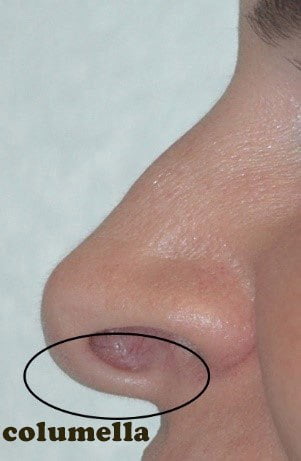The columella is formed of skin and cartilage, is the exposed portion below the nasal septum, or the partition that separates the left and right nasal

passages. The columella is a wall made of nose tissue that connect the nasal tip to the nasal base. This wall creates the nose base and preparing
its structures. The hanging columella is a cosmetic condition that is specified by a protruding or downward extending columella. A hanging columella is very noticeable especially in profile view and affect the aesthetic balance of the nose.
Variety of reasons can causes hanging columella. Usually, columella is a congenital condition or is related to the previous nose job that are explained as follow:
- Congenital condition. Some patients have hanging columella from the birth time. This hanging columella is originating from a disproportionately long septum that push columella downward. Or it may have occurred by the positioning and direction of the columella cartilage.
- Damage or prior nasal surgery. The prior nose job surgery can cause the hanging columella, that mostly is due to excessive cartilage resection or the alar and nasal retraction. More addition, columellar strut (is a cartilage graft to lift the nose tip or stabilize a newly shaped tip) can also causes the hanging columella.
Pertinent anatomy and etiology

The traditional medical books describe the proportion of columellar and alar as being able to see 2mm to 4 mm of columella below the alar margin when looking at the profile view of a person’s face. In this description, the appropriate position of the alar margin doesn’t describe properly. A patient may has hanging columellar due to the retracted alar. It is necessary to find out the reason of hanging columellar for the appropriate correcting operations.
Following are symptoms of hanging columellar:
- Excessive nostrils with a droopy tip
- A short upper lip
- Long lateral crus
- Strong lateral crus with no apparent notching
And the symptoms of semi-hanging columellar are:
- Presence of alar notching
- Weak or deficient lateral crura
- Retraction of the alar margin
- Alar margin with excessive curvature
A person may have hanging columellar naturally or it is occurred directly due to previous nasal surgery. If we want to evaluate the hanging columellar, the key nasal structures such as caudal cartilaginous septum, the membranous septum and medial and intermediate crus should be considered. The anatomic deformities that are related to the hanging columellar are as bellow:
- A caudal cartilaginous septum that is excessively long
- A redundant membranous septum
- A wide, curved, convex or vertically oriented medial/intermediate crura
- A long medial crus with bowing or a C-shaped curvature
- A broad vestibular vault and
- medial crura ptosis

If a hanging columellar is occurred due to the previous nasal surgery, the cause can include:
- A columellar strut or a caudal septal extension graft that protrudes caudally
- A suturing biphid medial crura that highlights the columella
- A shield graft that is too thick or excessive plumping grafts
- The loss of tip projection and rotation from previous rhinoplasty
The hanging columella treatment

The hanging columella can be a sign of alar notching or a retracted alar. In this condition, nostrils are pulled too far back. In some condition, both problems coexist. But the hanging columella treatment and a retracted ala are totally different. So these two conditions should be considering carefully. If the patient has a history of nasal surgery, the effect of primary nose job on the appearance of the hanging columella should be considered. Your doctor can determine the best surgical method if it is confirmed that columella is extremely hanging.
Surgical methods
The goal of columella reshape is creating a harmonious between columella and nostrils (also called the alar region). The surgical method probably includes minimizing the columella and lifting the cartilage upward. In this method, columella is bound to the septum behind the tip and prevent columella from rehanging. This is very sensitive procedure and should be done accurately. An experienced surgeon should attention to the nostril form, tip rotation, existence of alar notching, resistance and volume of the tip cartilage, the form of alar margin, nasal septum position and the coordination between nose tip and columella to the upper lip.












